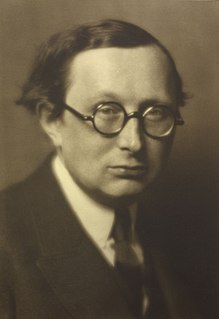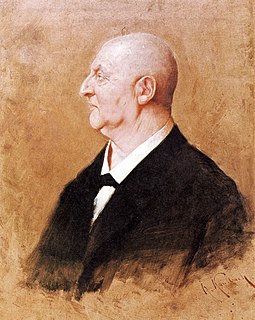Related Research Articles

Josef Anton Bruckner was an Austrian composer, organist, and music theorist best known for his symphonies, masses, Te Deum and motets. The first are considered emblematic of the final stage of Austro-German Romanticism because of their rich harmonic language, strongly polyphonic character, and considerable length. Bruckner's compositions helped to define contemporary musical radicalism, owing to their dissonances, unprepared modulations, and roving harmonies.

The Symphony No. 5 in B-flat major, WAB 105, by Anton Bruckner was written in 1875–1876, with minor changes over the next two years. It came at a time of trouble and disillusion for the composer: a lawsuit, from which he was exonerated, and a reduction in salary. Dedicated to Karl von Stremayr, education minister in the Austro-Hungarian Empire, the symphony has at times been nicknamed the "Tragic", the "Church of Faith" or the "Pizzicato"; Bruckner himself referred to it as the "Fantastic" without applying this or any other name formally.

Robert Maria Haas was an Austrian musicologist.

Anton Bruckner's Symphony No. 7 in E major, WAB 107, is one of the composer's best-known symphonies. It was written between 1881 and 1883 and was revised in 1885. It is dedicated to Ludwig II of Bavaria. The premiere, given under Arthur Nikisch and the Gewandhaus Orchestra in the opera house at Leipzig on 30 December 1884, brought Bruckner the greatest success he had known in his life. The symphony is sometimes referred to as the "Lyric", though the appellation is not the composer's own, and is seldom used.

Anton Bruckner's Symphony No. 8 in C minor, WAB 108, is the last symphony the composer completed. It exists in two major versions of 1887 and 1890. It was premiered under conductor Hans Richter in 1892 at the Musikverein, Vienna. It is dedicated to the Emperor Franz Joseph I of Austria.

The Symphony No. 9 in D minor, WAB 109, is the last symphony on which Anton Bruckner worked, leaving the last movement incomplete at the time of his death in 1896; Bruckner dedicated it "to the beloved God". The symphony was premiered under Ferdinand Löwe in Vienna in 1903.

Anton Bruckner's Symphony No. 1 in C minor, WAB 101, was the first symphony the composer thought worthy of performing, and bequeathing to the Austrian National Library. Chronologically it comes after the Study Symphony in F minor and before the "nullified" Symphony in D minor. The composer gave it the nickname Das kecke Beserl, and conducted its 1868 premiere. Much later, after Bruckner was granted an honorary University of Vienna doctorate in 1891, he dedicated the 1890 version of the work to that institution.

Anton Bruckner's Symphony No. 2 in C minor, sometimes known as the "Symphony of Pauses", was completed in 1872. It was actually the fourth symphony composed by Bruckner, after the Symphony in F minor (1863), the Symphony No. 1 in C minor (1866), and the Symphony in D minor (1869).

Anton Bruckner's Symphony No. 3 in D minor, WAB 103, was dedicated to Richard Wagner and is sometimes known as his "Wagner Symphony". It was written in 1873, revised in 1877 and again in 1889.

Anton Bruckner's Symphony No. 4 in E-flat major, WAB 104, is one of the composer's most popular works. It was written in 1874 and revised several times through 1888. It was dedicated to Prince Konstantin of Hohenlohe-Schillingsfürst. It was premiered in 1881 by Hans Richter in Vienna to great acclaim.
Benjamin-Gunnar Cohrs is a German conductor, scholar, and publicist on music.

The Mass No. 3 in F minor, WAB 28, is a setting of the mass ordinary for vocal soloists, chorus and orchestra, and organ ad libitum, that Anton Bruckner composed in 1867–1868.

The Requiem in D minor, WAB 39, is a Missa pro defunctis composed by Anton Bruckner in 1849.

Anton Bruckner's String Quintet in F major, WAB 112 was composed in 1878/79 in Vienna.

The String Quartet in C minor WAB 111, was composed by Anton Bruckner's in 1862 during his tuition by Otto Kitzler.

The Bruckner Gesamtausgabe is a critical edition of the works of Anton Bruckner. Published by Musikwissenschaftlicher Verlag Wien in Vienna, it comprises three successive editions.

The Symphonisches Präludium in C minor is an orchestral composition by Anton Bruckner or his entourage, composed in 1876. The work was discovered shortly after World War II. Heinrich Tschuppik, who found the orchestral score of the work in the estate of Bruckner's pupil Rudolf Krzyzanowski, attributed the authorship to Bruckner. Thirty years later, Mahler scholar Paul Banks, who knew only a four-stave reduction of the work, proposed that the work might be attributed to Mahler. While the exact circumstances of the composition of this Prelude have not been determined, it is certain to have been composed within the circle of Bruckner and his students at the Vienna Conservatory of Music. Based on the original orchestral score, it seems likely that the work was at least sketched by Bruckner, possibly as an exercise in orchestration for Krzyzanowski.

Gerd Schaller is a German conductor, best known for his performing and recording rare works, including the first full recordings of Bruckner's output.
William Carragan, American musicologist, is particularly known for his research into the music of Anton Bruckner. His primary concerns are analytical aspects of the music, and history of Bruckner performance. He is a contributing editor of the Bruckner Collected Edition in Vienna, sponsored by the International Bruckner Society.
References
- ↑ Korstvedt, p. 122
- 1 2 Korstvedt, p. 132
- ↑ Korstvedt, pp. 132–133
- 1 2 3 Korstvedt, p. 133
- 1 2 Johnson, Stephen (10 January 1996), Bruckner: guilty or not guilty?, The Independent, UK
- ↑ Korstvedt, Benjamin M. (2000), Bruckner: Symphony No. 8, Cambridge, UK; New York: Cambridge University Press, p. 105, ISBN 0-521-63537-3
- ↑ Watson, Derek. Bruckner Oxford: Oxford University Press
- ↑ William Carragan - The Bruckner versions, once more
- 1 2 William Carragan – A New Version of the Third Symphony
- ↑ Symphony No. 3 in D Minor, 1874 Version by Gerd Schaller
- ↑ Symphony No. 8, 1888 variant by Gerd Schaller
- ↑ Symphony No. 9 (Cohrs' edition of 2000) and sketches of the Finale by Nikolaus Harnoncourt
- ↑ Symphony No. 4 (1888 Version) by Akira Naito
- ↑ New Edition of the Bruckner Symphony No. 8 to receive its world premiere at Yale
- ↑ Symphony No. 5 in B Flat Major, 1876 Version
- ↑ Symphony No. 5 (Original concepts) by Akira Naito
- ↑ About the early version of Bruckner's Symphony No. 1 by Thomas Röder